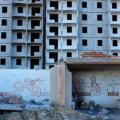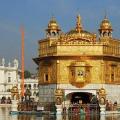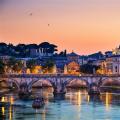Satellite map of the Czech Republic. Map of the Czech Republic Map of Austria and the Czech Republic
Map of the Czech Republic from satellite. Explore the satellite map of the Czech Republic online in real time. A detailed map of the Czech Republic was created based on high-resolution satellite images. As close as possible, a satellite map of the Czech Republic allows you to study in detail the streets, individual houses and attractions of the Czech Republic. The map of the Czech Republic from a satellite can easily be switched to regular map mode (diagram).
Despite the fact that the Czech Republic is a relatively small country in Europe, it manages to attract the attention of residents of many countries around the world. A large number of people who want to see the capital of the Czech Republic with their own eyes go on a trip to Prague. Such interest is understandable, because just what is it worth to walk through a European city at night!
Prague represents the historical value of all of Europe; a trip to the capital of the Czech Republic is impossible without visiting its main attractions. This is the medieval Prague Castle, the grandiose Charles Bridge, Lesser Town, the lacy St. Vitus Cathedral, Loretta's treasury. In addition, Prague is the main cultural and tourist center of the country. It looks like a fairy-tale city come to life with small, gingerbread-like houses and cathedrals,
decorated with many towers.
The special flavor of this amazing place has inspired many of the greatest writers and musicians. Milos Forman, Franz Kafka, Jaroslav Hasek, Antonin Dvorak - these names are inscribed in the history of Prague. There is still Mozart Street here, on
which houses the composer's museum.
A trip to Prague may well be pleasantly complemented by Czech cuisine and world-famous beer. The Czech Republic is proud of its ancient traditions of beer making and the variety of its varieties. This tourist destination is widely popular due to the fact that the cost of travel makes the Czech Republic one of the most affordable European countries.
Prices are affordable even on peak dates, such as New Year's holidays. New Year in the capital of the Czech Republic - Prague - will be a real time travel. The medieval city with cathedrals and turrets decorated with colored lights and garlands looks like a large set for a magic movie.
Traveling to Prague on New Year's Eve is an excellent holiday option with children, since the fabulous atmosphere reigning here will certainly be interesting and memorable for many years. Traditional symbols of the New Year in Prague, as well as throughout the Czech Republic, include mulled wine, Czech beer, colorful fireworks, and Christmas markets, which are traditional for winter Europe.
The analogue of Red Square in Moscow is Prague's Old Town Square. This is where you should definitely go to celebrate the New Year. After this, many usually continue to have fun on the Charles Bridge, where everyone asks for a wish to be granted from the statue of John Nenamucki. Give yourself and your loved ones an unforgettable holiday by traveling to Prague.
The Czech Republic or Czech Republic is a state in Central Europe. A map of the Czech Republic shows that the country borders Germany, Slovakia, Austria and Poland. The area of the country is 78,866 square meters. km.
Today the Czech Republic is the most developed of the post-socialist countries. The main sectors of the economy are mechanical engineering, fuel and energy, food, light and chemical industries. Recently, the importance of the metallurgical industry has been declining and foreign trade has been actively developing. The national currency of the country is the Czech crown. The Czech Republic is a member of the OSER, NATO and the EU.
The political map of the Czech Republic shows that the state is divided into the capital (Prague) and 13 regions. The largest cities in the country are Prague, Brno, Pilsen, and Ostrava.
Historical reference
The territory of modern Czech Republic was united in the 9th century by the Přemyslids as the protectorate of Charlemagne. This is where the claims of the German rulers to these lands came from. Bohemia (Kingdom of the Czech Republic) was formed on this territory. In 1041, the Czech Republic became part of the Holy Roman Empire. In the 15th century, the Hussite wars raged across the country. In the 17th century, the Czech Republic entered the Thirty Years' War, after which it came under the rule of the Austrian Habsburg dynasty.

In 1918, the unification of Slovakia, Carpathian Ruthenia and the Czech Republic into Czechoslovakia took place. In 1938, Slovakia seceded from Czechoslovakia. In 1939, the country was occupied by German troops, and after World War II it became the Czechoslovak SSR. The Prague Spring of 1968 (the fight against the Soviet regime) led to the introduction of Soviet troops into the country, and the struggle was brutally suppressed. The Velvet Revolution took place in 1989, resulting in the formation of the Czech Republic in 1993.

Must Visit
On a detailed map of the Czech Republic from a satellite you can see the main cities of the country, full of attractions: Prague, Brno, Karlovy Vary, Pilsen and Pardubice.
It is recommended to visit Prague Castle with St. Vitus Cathedral, Charles Bridge, Old Town Square, Vysehrad and the Jewish Quarter in Prague; Spielberg, St. John's Church and Old Town Hall in Brno; St. Bartholomew's Church and beer taverns in Pilsen; healing mineral spas in Karlovy Vary; Castles Karlštejn and Detinice. It is worth visiting the ancient cities of Kromeriz, Kutná Hora and Cesky Krumlov.
The Czech Republic is famous for its beer, so beers like Krušovice, Gamrinus, Pilsner Urquell, Velkopopovický Kozel, Budweiser and Staropramen are worth trying.
Note to tourists
Gulrypsh - a holiday destination for celebrities
There is an urban-type settlement Gulrypsh on the Black Sea coast of Abkhazia, the appearance of which is closely connected with the name of the Russian philanthropist Nikolai Nikolaevich Smetsky. In 1989, due to his wife’s illness, they needed a change of climate. The matter was decided by chance.Czechoslovakia is a state in the Center. Europe. 1918 to 1992
Nature. The relief of Chechnya is dominated by hills and mid-altitude mountains. Only in the South. and Yuzh. East there are lowlands - Pandunay (part of the Middle Danube Plain) and Potiska. Zap. part of the country is occupied by the Czech Massif, surrounded from Mon. Zap. Ore Mountains, from Mon. Skh.-Sudetes, with the West. and Yuzh. Zkh.- Czech Forest and Šumava. to the East the mountains of the Western system rise. Carpathians The most elevated part of the Carpathians is the Tatras, high. up to 2655 m (Gerlachovsky Štit is the highest peak of the Czech Republic and the Carpathians). Kam deposits have been discovered in the depths of the country. and brown coal, oil, gas, iron, manganese, copper, tungsten, lead-zinc ores, tin, mercury, antimony, fluorite, graphite, barite, pyrite, kaolin, magnesite, etc. materials, medicinal minerals, incl. including thermal waters. The climate is moderate continental. The usual January temperature ranges from -3° on the plains to -7° in the mountains of the Czech Massif and -10° in the Carpathians; July - from +20 to +8 and + 4 °, respectively. The annual precipitation on the plains is from 450 to 700 mm, in the mountains up to 2100 mm. The river network is dense. The largest rivers are the Danube (middle course) with its tributaries, the Vag and Morava, and the Laba (Elbe), with its tributary, the Vltava. Brown forest soils predominate, in the depressions - podzolized chernozems, in the Carpathians - mountain brown forest soils. Forests cover more than 30% of the territory. countries, ch. rank in the mountains. In the region there are coniferous (secondary) forests, in the Carpathians there are mixed forests. To protect nature, nature reserves have been created in Ch., including the Tatra, Krkonoše, and Pieniny national parks. Resort areas in Slovakia, more details.

Largest cities: Prague, Brno, Bratislava, Ostrava, Kosice, Pilsen.
Story. Human settlements on the territory. Ch. appeared during the Paleolithic. In the environment. 1st thousand N.E. ter. Ch. was populated by Slavs. tribes. In 7 tbsp. it was part of the political union formed by Prince Samo in the 9th-10th centuries - the Great Moravian state. The formation of the feudal system in Great Moravia was facilitated by the spread in the 9th century. Christianity. In 895, the Czech lands separated from the Great Moravian State, on which in the 10th century. A long-standing state was formed led by the Přemyslid dynasty.
Slovakia in the 11th century joined up. kingdoms. On ter. Ch. in the 11th century. two Slavs began to take shape. nationalities - Czech and Slovak. At 11-13 st. falls into the feudal period. fragmentation of the chess. and Slovak lands. In 1310-1437 hrs. the lands were part of the Din's possession. Luxembourg. King Charles I (see Charles IV) hon. the state turned into a powerful feudal-estate monarchy. In the 1st half. 15th century The national liberation and anti-Catholic Hussite revolutionary movement developed in the Czech Republic. In 1526 the Czech Republic, and in 1547 most of Slovakia (from the late 17th century - all of Slovakia) fell under the rule of the Habsburgs. their colonialist policies aroused resistance. and Slovak peoples (uprisings in the Czech Republic 1547, 1618 -20,1680,1775, in Slovakia - 1606, 1609, 1618, 1626, 1631 - 32, 1640, 1648, 1660, 1711, etc.).

From the end 18th century in the Czech Republic and from the beginning 19th century capitalist relations began to develop in Slovakia. End period 18 - 1st floor. 19th century characterized by the formation of ches. and Slovak nations, the rise of national movement, the struggle for the development of national culture. In 1848-49, the Czech Republic and Slovakia became the scene of revolution. events (see Revolution of 1848-49 in Austria, Revolution of 1848-49 in Hungary, Prague Uprising of 1848). With the formation of Austria-Hungary in 1867. lands became part of Austria. parts of the monarchy, Slovakia - in its Hung. parts. In the 2nd half. 19th century In the Czech Republic and Slovakia the labor movement acquired an organized character. In 1878, the Czechoslovyansk Social-Democrats were created. wages. party, 1905 - Slovak Social-Democratic Party party.
The entry into the stage of imperialism was aggravated by economic, social and national issues. contradictions within the Habsburg monarchy. During the First World War of 1914-18 in the Czech Republic and Slovakia, anti-government protests, as well as the surrender of Russians, became widespread. army chess and Slovak soldiers and officers. Great October. socialist the revolution contributed to the rise of the revolutionaries. and the national liberation movement. and Slovak peoples With the collapse of Austria-Hungary (1918), the Czech Republic and Slovakia formed a bourgeoisie. The Czechoslovak Republic (proclaimed on October 28, 1918), which included Transcarpathian Ukraine in 1919, contrary to the will and wishes of its population. As a result of the revolution. Through the struggle of the working people, the Slovak Soviet Republic was formed in 1919.

However, it was soon suppressed by the Czechoslovak bourgeoisie. government with the help of foreign imperialists. In 1918–20, the revolutionary movement swept the entire Czech Republic. The workers' struggle was led by the Communist Party of Czechoslovakia (CPC), created in 1921. In 1922, Czechoslovakia concluded a temporary agreement with the RSFSR and a similar agreement with the Ukrainian SSR (see Ukrainian-Czechoslovak Trade Agreement of 1922). Focusing on the west. state, the ruling circles of Ch. carried out a reactionary foreign policy. politics (see Versailles-Washington system). Under pressure r. mass government Ch. 1934 established diplomatic relations with the USSR and 1935 concluded with the Soviet Union. Union agreement on mutual assistance (see Soviet-Czechoslovak documents). Under the leadership of the Communist Party of Czechoslovakia, the working class of Ch. fought for the creation of the people. front, against the threat of fascism, for democracy. As a result of the Munich Agreement of 1938, the fascist. Germany occupied the Sudetenland, bourgeois-landlord Poland - Cieszyn Silesia, Horthy Hungary - southern. regions of Slovakia and Zak. Ukraine. On part of the territory. Slovakia Slovak In 1939, the Nazis formed an “independent Slovak state.”
In 1939 he was a fascist. Germany occupied the Czech Republic. During the tsim.-fascist. During the occupation, the Resistance Movement developed in Ch., headed by the Communist Party of Czechoslovakia. Czechoslovakians formed in the USSR. troops. units under the command of L. Svoboda took part in the hostilities of the Soviets. Army (see Sokolovo), including in the liberation of Kyiv. 12. XII 1943 signed by Soviet-Czech. Treaty of Friendship, Mutual Assistance and Post-War Cooperation. The Slovak national uprising of 1944 marked the beginning of the national democratic revolution in Czechoslovakia, an integral part of which was the May Uprising of 1944, which took place under the conditions of the liberation of the Czechoslovak Soviets. Army (see Prague operation 1945). During the period of national-call. the struggle of the peoples of China against the fascists. invaders formed the National. the front of the Czechs and Slovaks played a decisive role in the implementation of the national democratic and socialist revolutions in Czechoslovakia and began to fly. the basis of the new people's democratic government in Czechoslovakia. The program developed by the Koshitsky Communist Party of Human Rights (April 1945) was aimed at creating a people's democratic state of two equal nations - Czechs and Slovaks. On June 29 and 1945, an agreement was signed between Ch. and the USSR, according to which Zak. Ukraine, according to the will and desires of its population, was reunited with Soviet Ukraine. In February 1948, the working people of Czechoslovakia, controlled by the Communist Party of Czechoslovakia, won a decisive victory over the counter-revolution (see the February events of 1948 in Czechoslovakia), which marked the victory of the socialist revolution in the country. The IX Congress of the Communist Party of Czechoslovakia (May 1949) adopted the general line of building socialism in Czechoslovakia. The Constitution of 1960 consolidated the victory of socialism in Czechoslovakia and established a new name for the state - the Czechoslovak Socialist Republic (CSSR). In 1968 counter-revolutionary. forces within the country with the support of inter-r. reactions made an attempt to eliminate socialism in Czechoslovakia. But the leadership of the Communist Party of Czechoslovakia, headed by G. Husak, the broad masses of the working people of Czechoslovakia, relying on the international. assistance from the USSR and the countries of the socialist community, thwarted the plans of the counter-revolution and defended the gains of socialism. Since January 1, 1969, Czechoslovakia has been a federal state of two equal peoples - Czechs and Slovaks. The XIV Congress of the CPC (1971) adopted a program for building a developed socialist society in Ch. At the XV (1976) and XVI (1981) congresses of the CPC this program was concretized for the period of the sixth and seventh five-year plans. Czechoslovakia makes a significant contribution to the strengthening of the socialist community, peace and security of peoples. Czechoslovakia actively participates in the socialist economic integration of the CMEA member countries and in the Intercosmos program. 6 V 1970 between Czechoslovakia and the USSR signed a Treaty of Friendship, Cooperation and Mutual Assistance. Important history What was important was the conclusion of the 1973 Treaty between Czechoslovakia and the Federal Republic of Germany on the normalization of relations, according to which the Munich Agreement of 1938 was declared invalid. Czechoslovakia is a member of the United Nations (since 1945), the Council for Mutual Economic Assistance (since 1949), and the Warsaw Treaty Organization (since 1955).

Permanent link to the file - http://site/load/0-0-0-1008-20
+ additional material:
Where is the Czech Republic located on the world map? The Czech Republic is located in Central Europe. It borders on Poland from the north, Germany from the northwest and west, Austria from the south, and Slovakia from the east. The Czech Republic lies in the basins of such rivers as: Laba and Vltava. The eastern part of the country is in the Morava River basin.
The capital of the country is the city of Prague. You can find out about flight times to the capital of the Czech Republic from the article: how many hours is the flight to Prague?.
On a detailed map of the Czech Republic with cities in Russian, you can see that all the country’s rivers flow into three seas: the North, Black and Baltic. This country is famous for its cultural and historical monuments of culture and architecture. There are many ancient castles here (Karlštejn, Kutna Hora, Lednice, Cesky Krumlov), which you can see on a detailed map of Czech attractions. The most popular resorts in the country are Karlovy Vary, Marianske Lazne, Podebrady, Frantiskovy Lazne, etc. You can find Czech balneological resorts on a detailed map of the country.
 Zhanatas is the largest abandoned city in Kazakhstan. How the Sun affects people
Zhanatas is the largest abandoned city in Kazakhstan. How the Sun affects people Lost cities of India (11 photos) The most beautiful temples of India
Lost cities of India (11 photos) The most beautiful temples of India How to travel to Italy on your own?
How to travel to Italy on your own?